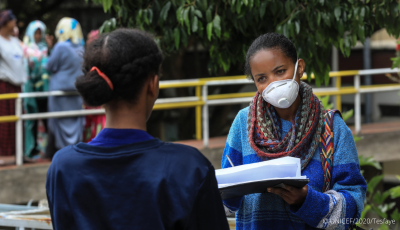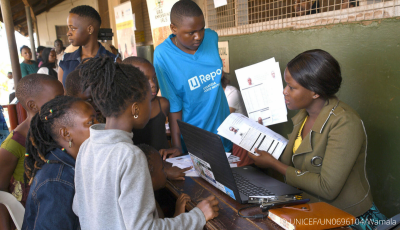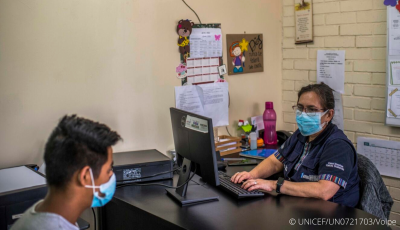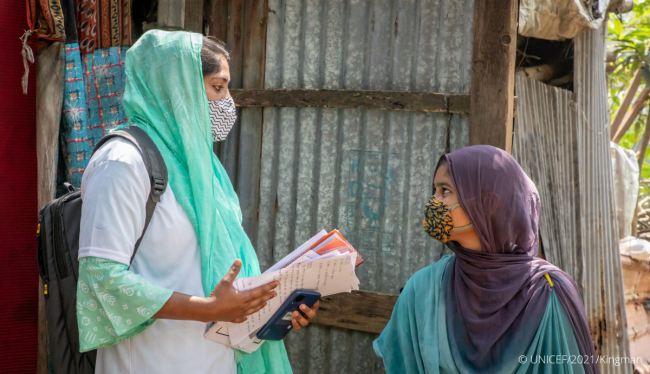
by Tomoo Okubo, Social Protection Specialist, UNICEF and Aniruddha Kulkarni, Global Technical Lead, Child Protection Systems, UNICEF (originally developed as a discussion paper by UNICEF and Global Social Service Workforce Alliance based on research by Julie Drolet, Professor of Social Work, University of Calgary)
Key Messages:
- Children and families, particularly the most vulnerable, including girls, children with disabilities, children on the move, and children without parental care, face multiple risks and deprivations across the life course. Social protection responses such as social transfers and social insurance programmes, as well as social care and support services for those with additional or complex needs, are key to addressing poverty and vulnerabilities.
- The social service workforce plays an important role within social protection systems by connecting children, individuals, and families with a range of social services across sectors.
- Despite the increasing challenge of poverty and vulnerability exacerbated by the COVID-19 pandemic, conflict and climate change, as well as the increasing recognition of the role of social service workers, investments in strengthening the workforce remain low across most countries.
- Building on country experiences and lessons learnt over the past years, this blog aims to clarify the role of the social service workforce in the social protection system. It also outlines key considerations for strengthening the social service workforce in their integral role in delivering effective and efficient social protection programmes and services.
1. Introduction
 Important commitments have been made under the 2030 agenda for Sustainable Development, ranging from ending poverty, reducing inequality, promoting health, developing education and skills, as well strengthening access to justice and ending violence. Central to this transformative agenda is the guiding principle of making sure that no one is left behind. This can only be achieved by combatting the structural causes which cause individuals, families and communities to face a range of risks and threats, and which leave many marginalized and socially excluded.
Important commitments have been made under the 2030 agenda for Sustainable Development, ranging from ending poverty, reducing inequality, promoting health, developing education and skills, as well strengthening access to justice and ending violence. Central to this transformative agenda is the guiding principle of making sure that no one is left behind. This can only be achieved by combatting the structural causes which cause individuals, families and communities to face a range of risks and threats, and which leave many marginalized and socially excluded.
While major progress has been made towards some of the goals in the 2030 agenda, multiple risks, including the COVID-19 pandemic, armed conflict in many countries, and the widening effects of climate change, are now threatening the progress made over many decades. The people and groups ‘left behind’ by social and economic development are disproportionally affected by these risks, leading them to experience higher levels of multidimensional poverty and social vulnerability. The need for connecting those in greatest need to timely, adequate and comprehensive social protection, including social transfers and targeted and integrated social services and support, is an urgent priority in achieving the SDGs and ensuring no one is left behind.
Social protection has become a key pillar of response to poverty and vulnerabilities facing children, individuals and families across the globe. Social protection is defined as ‘a set of policies and programmes aimed at preventing and protecting all people against poverty, vulnerability and social exclusion, throughout their life cycle placing a particular emphasis on vulnerable groups.’[1] Under this broad definition, the specific programmes offered are defined under each country’s strategies, policies or frameworks, and they commonly include:
- Social transfers (such as cash transfers, tax credits, in-kind transfers)
- Social insurance (such as health insurance, unemployment insurance)
- Labour and jobs programmes (such as family friendly policies and livelihood programmes)
This note focuses on the integral role of the social service workforce in social protection systems, and in particular, in ensuring access to social protection programmes such as those outlined above, combined with services of support, care or protection for people with additional needs.
The social service workforce has a unique and critical role in addressing poverty, vulnerability, gender inequality and social exclusion at a systemic level. Social service workers do so by developing a comprehensive understanding of the needs of children and families, carrying out assessments, developing case plans and connecting them with necessary support and services across sectors. However, for the social service workforce to effectively perform these functions, they require adequate investment and support. To help inform the investment required, the following sections explore who comprises the social service workforce, their key functions – especially in social protection programmes and services, and the important considerations in strengthening the workforce.
2. Understanding the workforce: who are they and what roles do they play?
 The social service workforce is defined by the Global Social Service Workforce Alliance as including both paid and unpaid, governmental and non-governmental, professionals and para-professionals, working to ensure the healthy development and well-being of children and families.[2] Concretely, the workforce is composed of people with a range of job titles, including (but not limited to) social workers, social educators, social pedagogues, child-care workers, youth workers, child and youth care workers, community development workers, community liaison officers, community workers, welfare officers, social or cultural animators and case managers.
The social service workforce is defined by the Global Social Service Workforce Alliance as including both paid and unpaid, governmental and non-governmental, professionals and para-professionals, working to ensure the healthy development and well-being of children and families.[2] Concretely, the workforce is composed of people with a range of job titles, including (but not limited to) social workers, social educators, social pedagogues, child-care workers, youth workers, child and youth care workers, community development workers, community liaison officers, community workers, welfare officers, social or cultural animators and case managers.
While social work as a profession has developed over a long period of time, and in many countries is the dominant profession in the social service workforce, this brief takes into account the wider workforce, as other categories of professionals and para professionals have evolved over time and also make invaluable contributions to care, protection and support for people in need, and to achieving social justice.
A dedicated and qualified social service workforce is essential to coordinate efforts and resources and to provide a system of support for children and families that coordinates inputs across all sectors. While the most commonly understood role of social service workers may be related to their role in delivery of response services – in directly reaching the families and children in need, it is important to recognize the role of social service workers as extending beyond response, and covering a wide range of promotive, preventive and rehabilitative functions, provided at macro, mezzo and micro levels, across all sectors.[3]The three main categories of services can be understood as follows:
RESPONSE SERVICES
At the micro level, the social service workforce respond to identified needs by:
- Offering the first point of contact for children, families and other individuals in need of support, care or protection;
- Assessing and determining the needs and best interests of children and families, and others in need, across the life course;
- Assisting people in need with accessing social protection programmes, and coordinating those programmes with other social services, including social care, child protection, protection from gender-based violence, mental health services and psychosocial support;
- Connecting people with, and ensuring their access to, other sources of help, including relevant health, education, protection, legal and livelihood services.
PREVENTIVE SERVICES
While responding to address immediate needs and risks is critical, intervening early to prevent or mitigate those needs or risk factors and vulnerabilities, has more potential for achieving long-term benefits, and is therefore also the most cost-effective approach. Prevention work by the social service workforce is undertaken at both mezzo (for a whole community) and micro levels (for individuals and families). Preventive services include:
- Community outreach to identify families and children with additional needs and vulnerabilities (including living in poverty or at risk of poverty).
- Providing them with access to relevant social protection schemes, including social transfers, social insurances, employment support, and social services to prevent them from falling into poverty and destitution, to reduce vulnerability, to build resilience and life skills (e.g., parenting) and to address additional needs (e.g., for children with disabilities and their families, young people leaving alternative care etc.).
- Through community outreach and awareness raising, identifying and addressing social norms and harmful behaviours that would otherwise contribute to social problems.
PROMOTIVE SERVICES
Social service workers who work at the macro level oversee the functioning of overall systems of social protection and social services, including planning, delivery, monitoring and evaluation. Specifically, they work to secure and manage budget allocations; advocate for and develop policies and programmes; oversee human resources and social service institutions, manage reviews and evaluations of the system; and steer strategic shifts in the way the system is managed. Social service workers can also undertake a range of promotive functions at the mezzo level, such as mobilizing entire communities to protect children and facilitating dialogue with community leaders. As poverty and vulnerability are often rooted in structural inequities and discrimination, the social service workforce can also play a transformative role in changing the power imbalances that create and sustain poverty in all its dimensions, vulnerability, discrimination and social exclusion.
Finally, in understanding the wide range of functions that the social service workforce can perform, it is important to acknowledge that these functions should be offered through a coordinated network of interventions and support. For example, a community worker or volunteer may identify families at risk of poverty and link the families with a local officer who administers cash transfer programmes. Likewise, a social worker can identify children and individuals who may already be included in social protection programmes but are also at risk of violence, and refer them to protection services. Building such an integrated network of services allows families to access a range of types of support, and ensures quality services are available when and where they are most needed. Within such a network, it is important that the social service workforce across sectors have a clear understanding of their individual functions, that other professions recognize and respect their roles, and that effective coordination and case management mechanisms, that reach across sectors, are available to ensure seamless referral, support and follow-up.
3. Ways forward – key considerations in strengthening the SSW in the social protection systems
 While the importance of social services workforce is clear in building comprehensive social protection systems, too often the investment and support to strengthen the social service workforce are limited. While acknowledging that challenges vary significantly across different contexts, we focus on three key considerations for policymakers in strengthening the social service workforce within the social protection systems.
While the importance of social services workforce is clear in building comprehensive social protection systems, too often the investment and support to strengthen the social service workforce are limited. While acknowledging that challenges vary significantly across different contexts, we focus on three key considerations for policymakers in strengthening the social service workforce within the social protection systems.
Is there a clear vision of individual functions, coordination, referrals, as well as a clear set of coordination and referral systems across sectors?
It needs to be clear who does what and when, in a given case. This requires ministries and implementing agencies to come together to develop and improve joint standard operating procedures, that cover assessment, decision making, referral, follow-up and review. Strong referral and coordination systems also require professionals, para professionals and community volunteers across sectors - not only in the SSW but also in allied sectors such as health, education and justice - to be regularly trained together. This helps building cross-sectoral working relationships based on trust and mutual recognition.
Are governments investing enough in the social service workforce for them to be able to fulfill these functions?
Despite the urgent needs, the number of social service workers is often limited, and inadequate for them to perform all their essential functions, at different levels.[4] This leads to families and individuals not having access to the right level and type of quality services of social care support and protection, when most needed. It also leads to overload among the social service workforce. Building a social service workforce takes high-level commitment and resource allocation, particularly at national levels.
Human resource needs should be met to enable the workforce to effectively administer and implement integrated support, including for integrated/cash plus programs. Sufficient human resources will also ensure that social service workers and social protection administrators are not overwhelmed with excessively high caseloads, which could in turn lead to prolonged stress, burnout, high turnover and reduced service quality.
Is the arrangement of functions and services designed to be accessible and coordinated from the perspective of families, children and individuals?
A common experience of people seeking help to address complex social needs is that, even if they can access one type of help, e.g. a cash transfer for parents of a young child or child with disability, they struggle to access help to address other needs or risks, e.g. poor or insecure housing, a suitable school for a child with special needs. Excessive time and effort spent seeking different forms of help can have a range of adverse effects, from loss of confidence and motivation, to heightened risk. Even when help is accessed, it is often not coordinated or incompatible. Accessing one type of help, such as employment or housing, might result in the applicant losing their ability or entitlement to access equally important services such as suitable child care, schooling or protective services. Furthermore, inquiries into the reasons why services to protect children or women from violence often fail have found one of the most common reasons to be lack of information sharing, risk assessment and referral systems that cross agency and district boundaries.[5] Investment, planning and capacity building is therefore needed to develop and sustain a workforce that can apply a ‘no wrong door’[6] approach to ensure all key types of help are accessed by those in need, and a coordinated, inter-agency approach to protect those at risk. To provide such services requires a needs-led, rights-based, and person-centred approach, which focuses on ensuring that support, care and protection is responsive and tailored to individuals and families’ needs. This should be the approach taken by social service workers, including those involved in administering and providing social assistance including cash transfers and other programmes, characterised by a determination to stay with the individual or family till their problem is fully resolved, while helping build their coping strategies and resilience in the long-term.
End Notes:
[3] UNICEF (2019) Guidelines to Strengthen the Social Service Workforce for Child Protection
[4] Although there is no single recommended ratio of number of social service workers to a given population, and one would be hard to define as local contexts and definitions of the workforce vary widely, GSSWA reviews (2017-2019) covering close to 50 low and middle income countries reveal mostly very low ratios, ranging from 0.3 per 100,000 children in West Bengal, India, to 781.2 per 100,000 children in the Maldives, but averaging about 50 per 100,000 child population. By contrast, WHO recommends a minimum ratio of 445 doctors, nurses and midwives per 100,000 total population. However, the definition of SSW used in many of these national estimates does not include the full range of community volunteers and para professionals often involved at the most local level.
[5] The Victoria Climbie Inquiry: report of an inquiry by Lord Laming (2003) and Every Child Matters (2003) HM Treasury, UK. https://www.gov.uk/government/publications/every-child-matters
[6] No Wrong Door: A Holistic Approach to Human Services (undated). Developed and written by the Governing Institute (USA) custom media division, with information and input from RSM.
Resources:
BASW and CWIP. (2019). Anti-poverty Practice Guide for Social Work. Birmingham. British Association of Social Workers. https://www.basw.co.uk/system/files/resources/Anti%20Poverty%20Guide%20A...
Global Social Service Workforce Alliance (GSSWA) Resources, including regional mapping reports: https://www.socialserviceworkforce.org/alliance-developed-resources
GSSWA (2015). Para Professionals in the Social Service Workforce: Guiding Principles, Functions and Competencies. 2nd edition
GSSWA (2017). Global Advocacy Toolkit for the Social Service Workforce
GSSWA (2019). Guidance Note on Defining the Social Service Workforce.
Martorano and Sanfilippo (2012) Innovative Features In Conditional Cash Transfers: An Impact Evaluation Of Chile Solidario On Households And Children. UNICEF Innocenti Working Paper. https://www.unicef-irc.org/publications/pdf/iwp_2012_03.pdf
UNICEF ECA (2018) Strengthening the Social Work and Social Service workforce in Europe and Central Asia as an Investment in Our Children ’ s Future: A Call to Action. https://www.unicef.org/eca/media/6621/file/Call-to-action-Monitoring-Fra...

